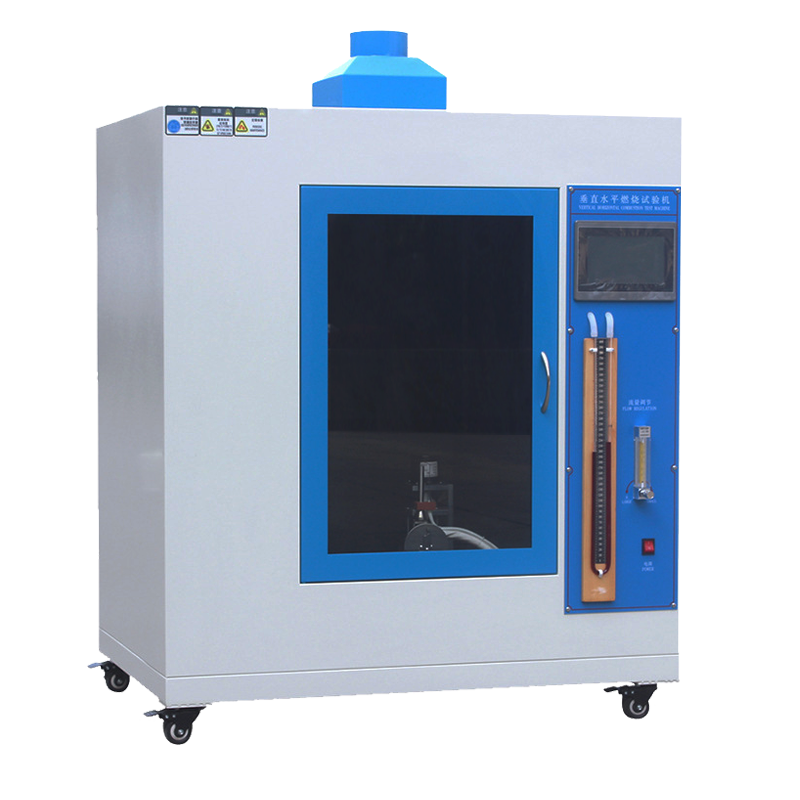Professional Vertical Combustion Tester, Ideal for Material Flammability Testing
Product description
STANDARD FEATURES
| Burning Chamber Capacity | ≥0.75m³ with glass observation door |
| Burning Angle | 20 。, 45 。, 90 。 (ie 0 。) adjustable |
| Flame Time | 0 ~ 99 minutes 99 seconds can be set |
| After Flame Time | 0 ~ 99 minutes 99 seconds can be set |
| After Glow Time | 0 ~ 99 minutes 99 seconds can be set |
| Burner Dimensions | The inner diameter of the nozzle is Ø9.5±0.3mm, the effective length of thenozzle is 100±10mm, and there is an air adjustment hole |
| Combustion Gas | LPG gas (Customize) |
| Flame Height | Adjustable from 20mm to 175mm as standard |
| Features | It is also equipped with lighting device, air extraction device, gas flow regulatingvalve, gas pressure gauge, gas pressure regulating valve, gas flow meter, gasU-shaped pressure gauge and sample fixture |
| Power | AC 220v 50HZ |






I. Equipment Functions and Features
Vertical combustion test capability: Emphasize the ability of the equipment to conduct vertical combustion test on the material, simulate the flame conditions encountered by the material in actual use, and evaluate the flame retardant property of the material.
Automated operation: Equipped with automatic ignition, timing, recording of test data and other functions to reduce human error and improve testing efficiency and accuracy.
Multiple testing modes: Supports different testing standards and methods, such as UL 94, IEC 60695, etc., to meet the testing needs of a wide range of materials.
Precise Flame Control: Can accurately adjust the flame height, temperature and application time to ensure the consistency and repeatability of test conditions.
Data recording and analysis: can record key data such as burning time, self-extinguishing time, flame spreading speed, etc., and generate test reports, which are convenient for users to analyze and archive.
II. Technical Parameters
Combustion chamber size: Provide the internal size of the combustion chamber to ensure that it can accommodate different sizes of test samples.
Flame Height Adjustment Range: Indicate the adjustable range of flame height to adapt to different testing requirements.
Temperature Measurement Accuracy: Label the accuracy of the temperature sensor to ensure the accuracy of the test temperature.
Timing accuracy: indicate the accuracy of the timer to ensure the reliability of the combustion time record.
Gas supply requirements: specify the type of gas required and pressure requirements, such as methane, propane, etc.
III. Application Scenarios
Electrical and electronic industry: Used to test the flame retardancy of materials such as electronic equipment shells, circuit boards, wires and cables, etc., to ensure the safety of products in case of fire.
Building materials industry: Evaluate the flame retardant level of building materials such as plastics, rubber, textiles, etc. to meet the requirements of building regulations and safety standards.
Automotive manufacturing industry: Flame retardant testing of automotive interior materials, wire sheathing, etc., to improve the safety and reliability of vehicles.
Textile industry: Testing the flame retardant performance of textiles to ensure that they meet the relevant safety standards, applicable to special occasions such as fire resistant clothing, airline seats, etc.
IV. Safety and Compliance
Compliance with international standards: Emphasize that the equipment complies with international standards such as UL, IEC, ISO, etc. to ensure the authority and credibility of the test results.
Safety protection design: with automatic flame failure protection, overheating protection and other functions to prevent the operator from being harmed and to ensure the safe operation of the equipment.
Quality certification: Mention the CE, ISO 9001 and other quality certificates obtained by the equipment, reflecting the quality and reliability of the product.
V. Use and Maintenance
Operational simplicity: describe the equipment's user-friendly interface, easy to start, reduce training time and cost.
Maintenance Requirements: Provide suggestions for routine maintenance and upkeep, such as cleaning the combustion chamber, checking the gas piping, etc., to extend the service life of the equipment.
Technical support and after-sales service: Emphasize the technical support and after-sales service provided by the manufacturer, including equipment installation, training, maintenance, etc., so that the user has no worries.
Recommended products

